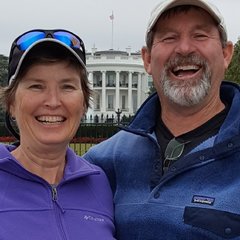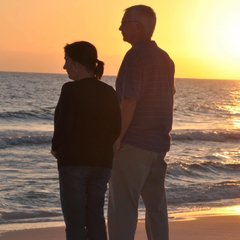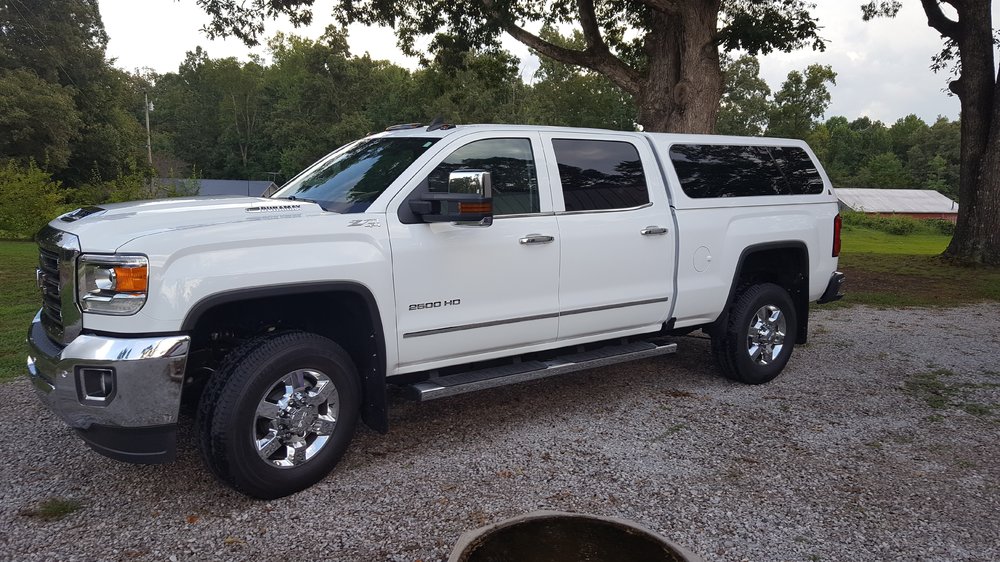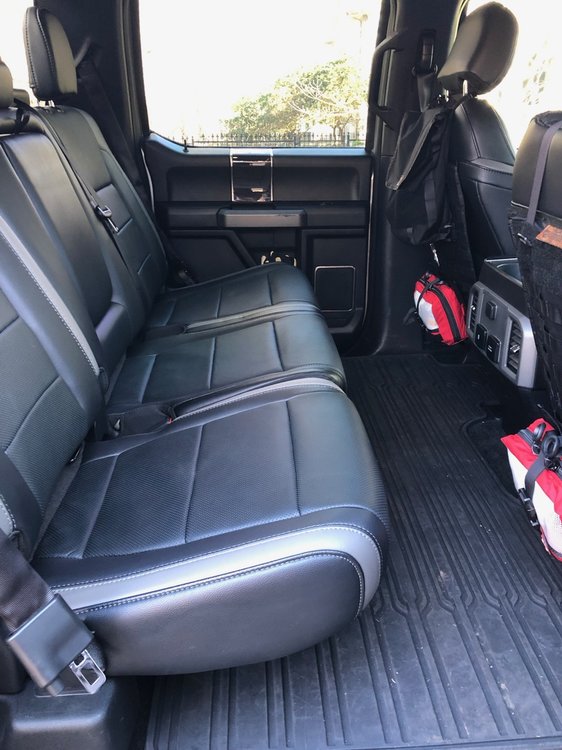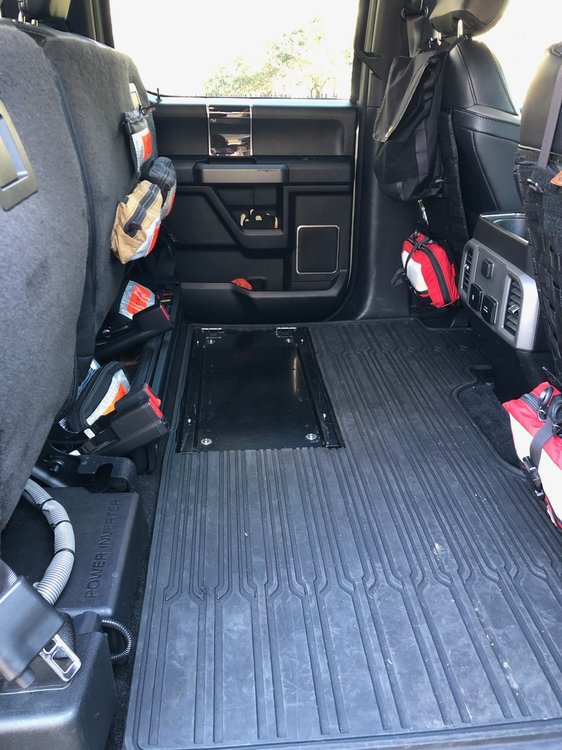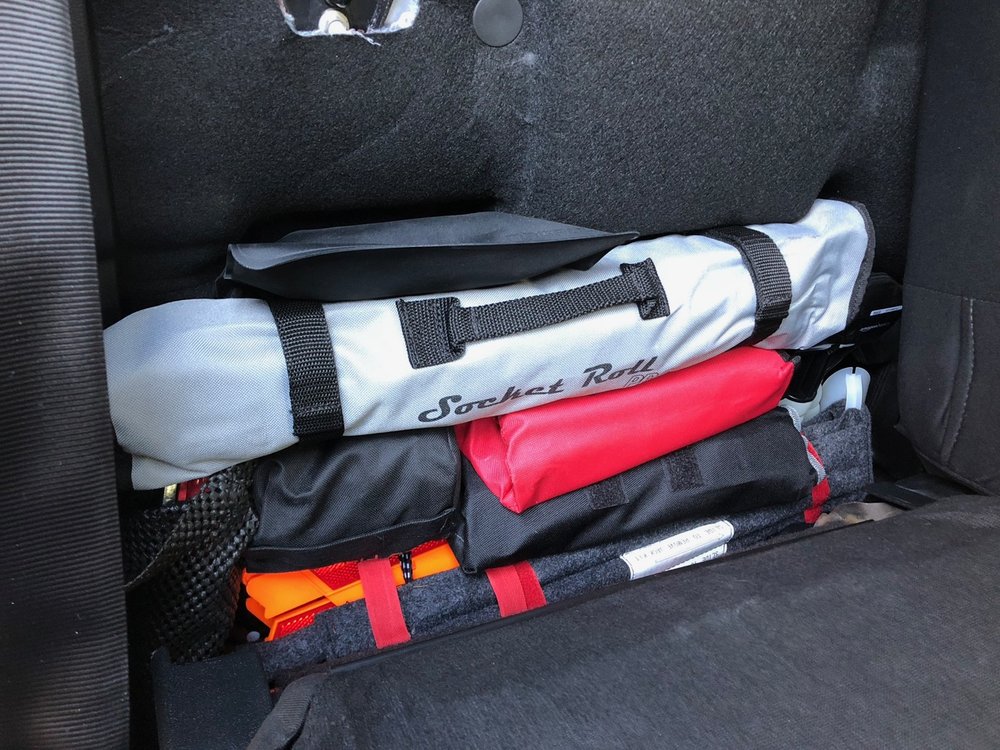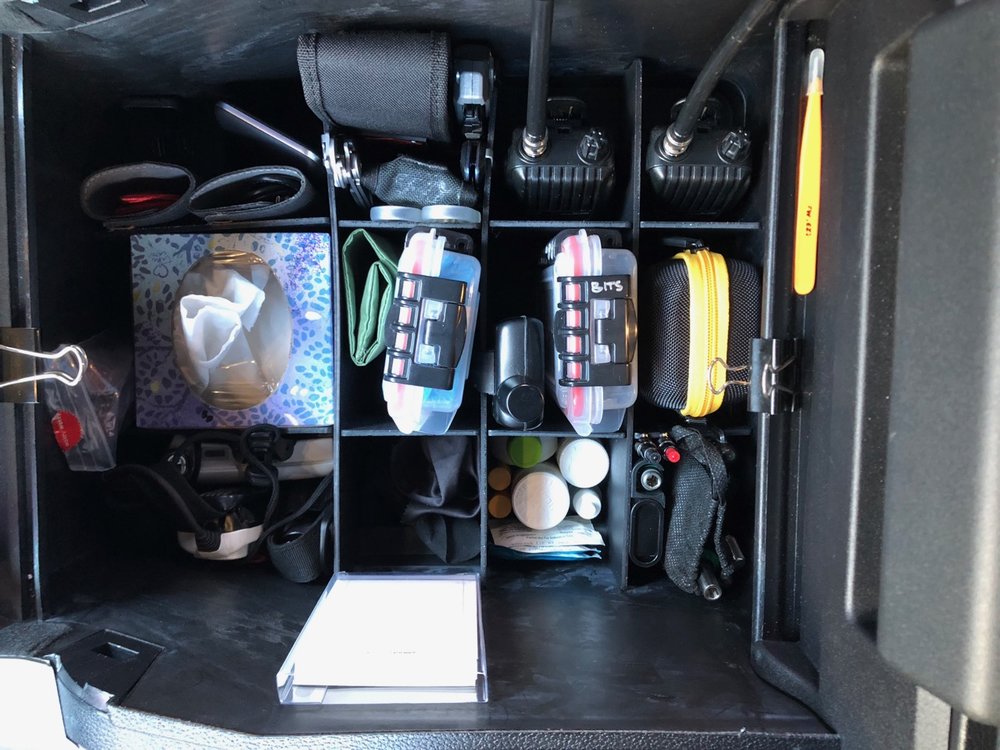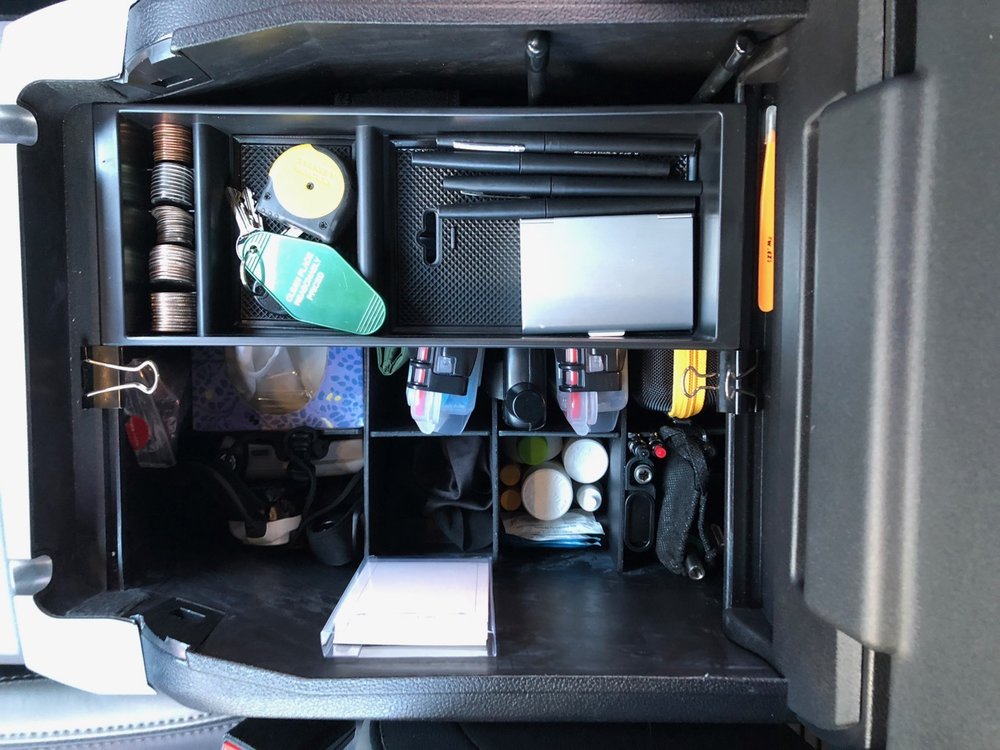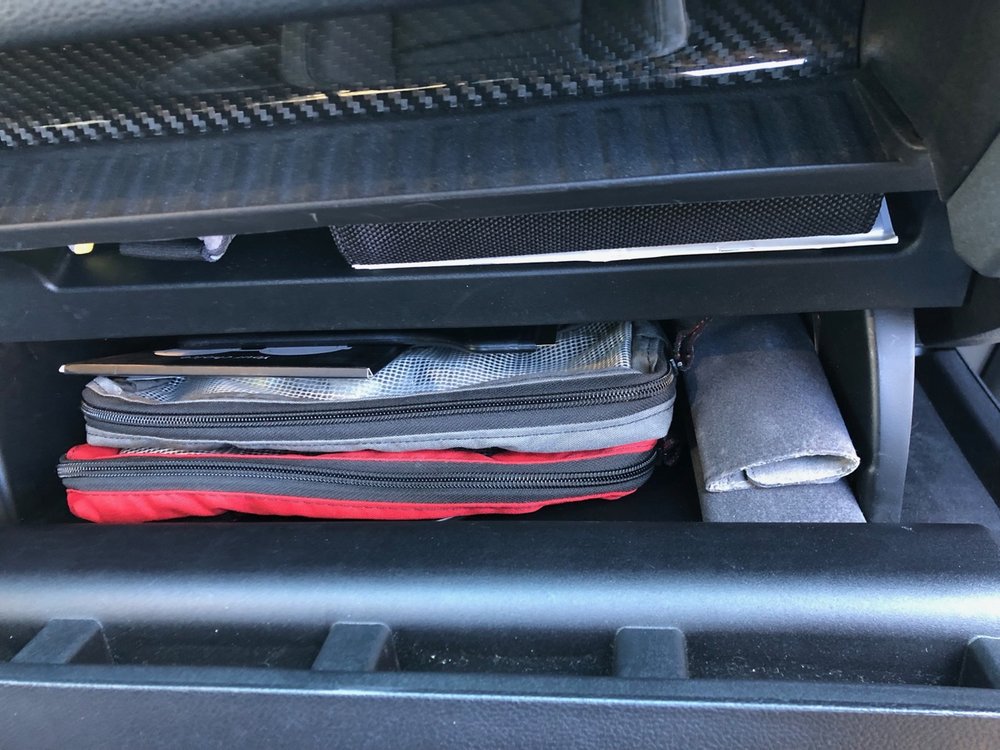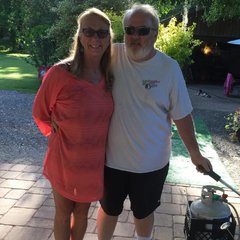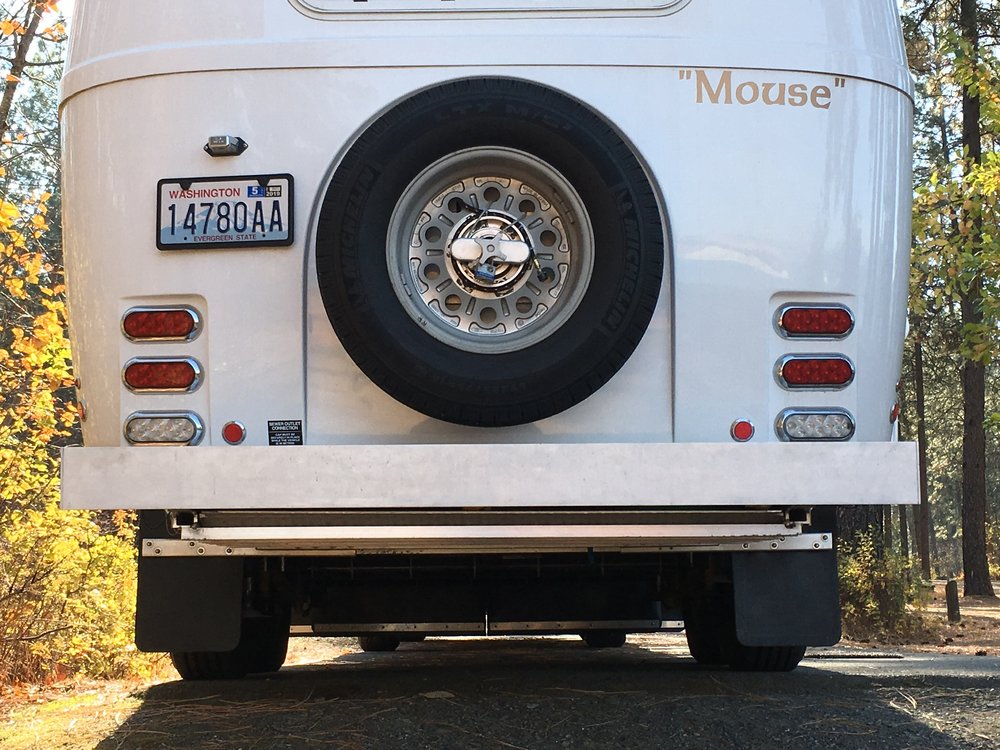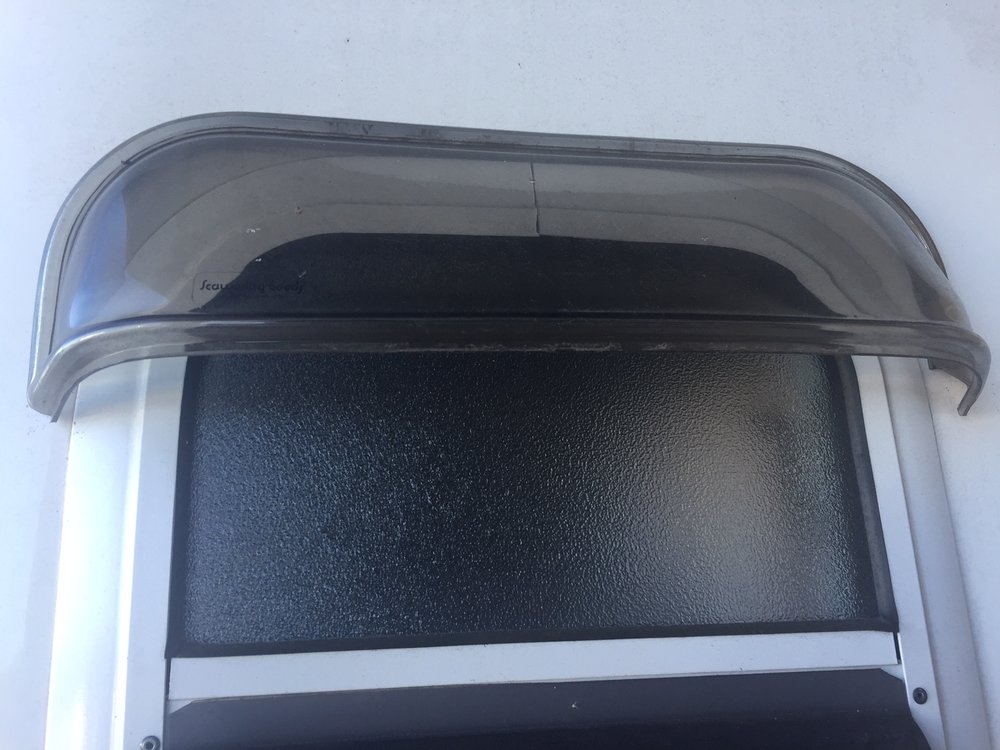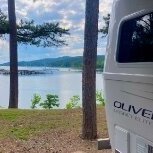Leaderboard
Popular Content
Showing content with the highest reputation on 01/30/2019 in all areas
-
We have two pickup trucks a 2003 2.4L manual 5 speed Tacoma and 2016 5.7L 4X4 Tundra. Purchased the Tundra new for $37,000 and works fine for us towing our LE2, should not need replacement for years. We will eventually replace the 2003 Tacoma that we purchased new for less than $13,000, it only has 165,000 miles and runs great, so it will probably be years before it needs to be replaced with a mid sized pickup. We tow our LE2 with empty tanks and keep Ollie lightly loaded for local trips and cross country from the Carolinas. We see fuel economy between 12 and 13MPG, depending on speed and terrain. I have been guilty of taking excessive gear/supplies camping that we never used, so that's one way to reduce overall weight when camping. We have a Diamond Back cover on the Tundra that's light & handy for our camping needs. Weighed our Tundra/Ollie rig and Tundra on CAT Scales during 2017 & 2018 and rig is under all of Tundra's maximum capacities, but loading is important where gear is stored. Our longest Tundra/Ollie tow day was 720 miles so far (Tundra has 38 gallon fuel tank) we were in a hurry to get back to the Carolinas from CO when a hurricane was approaching home. Here's a shot of our rig with Diamond Back cover camping in TN: Nothing to do with this conversation, took this Vintage Dodge Power Wagon photo at a Vintage aircraft gathering at Lock Haven PA, always liked the looks of this truck, since we like pickup trucks!!!!!!!3 points
-
I have not driven a Nissan Titan but my go-to source for reviews is Car and Driver and they hate the diesel version. The 5.0 has so much to promise. Maybe with an aftermarket tune it would be really good. I would love to see a refined version of that lighter shorter engine offered in a Power Wagon..... Ram was originally going to use that engine, they cancelled the project and Cummins sold them to Nissan. https://www.caranddriver.com/nissan/titan-xd In reality, any big V8 gas engine will have the power you need unless you must have the cruising range, which is not an insignificant factor - fuel tank worries vanish when you can tow 600 miles before refueling. The BIG factors are always payload, axle ratios, and how much you plan to drag around in the truck. Keep the Tundra, it will do just fine. You have the power and the gearing you need, though you might want to add rear airbags for levelling. Unless it doesn’t carry enough stuff, then you can do something about it. Maybe a new Tundra HD Diesel will be available next year, they are doing work on the replacement model, though nobody knows if we will ever get a diesel like the rest of the world.. I would buy that truck in a heartbeat. Nissans don’t hold up like Toyotas. The buld quality just isn’t there, even in their high end luxury SUV. https://www.motor1.com/news/302530/2020-toyota-tundra-spied-first-time/ Calculate how much money you would lose by trading in your current truck. I bet it would buy a whole lot of gasoline.... John Davies Spokane WA3 points
-
It is a tough thing to do - replace a truck you love, especially one so close to meeting the demands of the task at hand. However, once I decided my old truck was just not up to the task - hauling my Oliver EII around North America - I mentally moved on to finding a replacement. The old GMC brought a nice return, and the new owner was very happy. Some of the new 1/2 ton trucks are fine hauling a EII, I wanted a 3/4 ton - payload was why. Planned to add a camper top, and haul around all our gear, boats, bikes, a menagerie of play toys, and the ever present cool and (un) necessary camping "stuff". Gas? - Diesel? Ford/GMC/Ram?, or something else. $70k+ wow, jeeze, really, that's a lot of $$$, for a truck... Like every purchase of this magnitude, you go do the research. $10k for the Diesel over gas, but performance is almost twice that - for towing, fuel mileage when towing also better, fluids more expensive, more complexity, OK, really look at a gas truck. I did, towing fuel mileage, was horrible, run the numbers. If I keep the diesel for 100K miles, the extra $10K starts to approach $$ parity. Diesel it is. Ram - not in the game - my choice. The other truck mfg. DO NOT build a comparable truck - 3/4 ton- anything less is not the same. Take a look underneath, chassis and axles are not as HD. Close, but not the same. I love Toyota, helped build Nissans, own a Honda, but they don't build a 3/4 ton truck. Not going to argue GM over Ford. I test drove both - several times - over several weeks, knew everything about them - everything!. I finally went with the 2018 GMC 2500 Duramax, with Allison transmission. Proven powertrains. I am very happy with my choice. The WWW has enough info out there to make an informed choice, real world testing just reinforces what you read. Salespeople, usually are just ignorant on their products - my observations. I'd prefer dealing with a robot. In a GMC, the SLT is the sweet spot, no need to go upscale to Denali, same with Ford - the Platinum is more bells and whistles, $$$ for stuff I didn't need or want. I found the GMC I wanted, for <$60K. Took some effort, but it was worth it, and my SO was happy - win. Ultimately, it was a leap to pay up for the Oliver, but once we did, it did not make sense to purchase a TV that was not similar - tops in its class. Several thousand miles and multiple trips more than confirm the choices - I love the Oliver, and getting to and fro, in the GMC, is just a comfortable, easy feeling. We are happy. As has been stated, take your time, tow with your current set-up, evaluate, discuss, really understand where you plan to go in this vast country, how often, and once you feel comfortable understanding the variables, you may be content with your current TV, if not, well - the rest is just money (ha ha) and decision. Hope this helps, enjoy the process, have fun, May the force be with you... RB [attachment file=20180820_162145 (693).jpg]3 points
-
Like a lot of people a year or so into ownership, I've been working lately on reducing the amount of stuff I carry - getting rid of things we never use and also finding strategies of making what we do carry lighter and more compact. I've also been working on a dedicated toolkit that would just stay in the truck permanently, so I don't have to worry about packing tools up and inevitably forgetting the one tool I need that trip. So what I've been after is, 1) a complete toolkit that has everything I might reasonably need for roadside or campsite repairs; 2) compact enough that it can be stored in the cab of the truck permanently, without being in the way; 3) can be stored in a way that still gives easy access when traveling; i.e., I don't have to completely unpack the truck to get to them; and 4) contains quality tools that can be relied upon. Certainly the easier solution is to ignore requirement #2 and just put a toolbox of some sort in the bed of the truck. I think that's perfectly fine; but personally, I'd rather keep them in the cab to protect them from moisture, trail dust, theft, and getting all scuffed up from being jostled around. Plus by keeping everything compact, I'm also forcing myself to keep the weight down. So in the following posts, I'm going to try to list all the tools I've placed in my kit, the reasons for choosing what I did, and then some ideas on how to best store them in your vehicle. The tools I've included are, as I said, what I think constitute a "reasonable" tool kit for repairs while traveling. "Reasonable", of course, is subjective. If you're the type who is likely to call Good Sam to change a flat tire (nothing wrong with that), then your "reasonable" might be limited to a few screwdrivers and a pair of pliers. On the other end of the spectrum, there are guys over on Expedition Portal who wouldn't go to the grocery store without a welder in their Jeep. And nothing wrong with that, either - to each his own. With that in mind, I'd like to think that my following posts are just a starting point for conversation. I'd love to know what others think about these choices - surely I've forgotten something, or one of you knows some better options or alternatives. With some additional voices, hopefully this thread can provide some guidance for new owners or others like me who are looking to pare down what they've been carrying. Fair warning, I do like nice tools, and have a thing for German tools in particular, so some of the stuff listed below is pricey. But I don't think that there's anything here for which you couldn't find a decently priced alternative, and arguably a better value. Or, you might be the guy who doesn't accept anything shy of Snap-On. Either way, buying all of these at once will put a good dent in your checkbook, even if you're shopping at Harbor Freight. So keep in mind that this isn't intended to be a "must have" list. Like I said, you probably don't "need" any of this. All you really need, in most situations, is a cell phone. But if you do decide to put together a toolkit of any size from scratch, I suggest you make an Amazon list and then set price alerts for each tool using 3 Camels (www.camelcamelcamel.com). That way you can buy at the lowest price and spread your purchases out over several months to make the cost seem more palatable. (I've also found after explaining that strategy to my wife, that when the packages arrive, she asks how much we saved vs complaining that I've bought yet another tool.). Actually, she does both, but I think there's less complaining than before.2 points
-
I'll give you another reason to not like the chip sealing method of repairing roads. As a road goes from good to worse cracks form and potholes appear. Chip sealing fills in those cracks and potholes making for a nice looking surface - for a time. However, those cracks and potholes develop for a number of reasons to include improper road bed construction. Obviously, if nothing is done to repair the base of the road then many of these cracks and/or potholes will simply reappear in fairly short order. Perhaps if one does a proper cost analysis it just still might be cheaper to use this chip/seal method. But if you consider the costs of higher frequency maintenance, total traffic delays (i.e. several short term delays versus one long delay), repair costs for bodies and windshields, and vehicle cleanup time, I'm guessing that at best the cost is a wash. Besides, like Grandpa used to say, "if you're going to do a job, do it right the first time". Another thought - it would seem that there are a fair number of us that like to keep our Olivers clean and with as few chips in the gelcoat as possible. However, I know of a good number of people that actually like things like chip/seal. They even seem to seek it out! Apparently the objective is to see just how much of that "stuff" they can collect so that it holds that rusted bucket of bolts together. Kind of like a spray in liner for the entire underside and sides of the vehicle. Heck - if you find a nice dirt road shortly after doing 20 miles of chip/seal - the vehicle will look exactly the same from top to bottom and it will be somewhat protected from even more rust. Bill2 points
-
I would tip toe into this. We had a Trunda Limited we traded for our GMC. We are planning much longer trips these days and hope to be on the road more over the next few years. Don't misunderstand, the Tundra did a good job pulling our E2. It was maxed out but had no problem pulling it. Yes our 3/4 ton does a much better job and is more relaxing when towing. I can't give any help on the Nissan but will say this. I payed 10k more for a top of the line GMC. I would think the Nissan should be capable but would not settle for something less then what I wanted when spending that kind of money.2 points
-
Wow, what a gold mine of good info and tools. Two tools that I use a lot are a small and larger curved jaw Vice Grips. Thank you for documenting your great tool selection and providing the rationale behind your choices.2 points
-
Storage I'm not a fan at all of tool boxes for inside the vehicle. They're noisy, bulky, and your tools get scuffed up. If you're keeping your tools in the back of the truck and don't care if they get banged around, then go for it. I have mixed feelings about tool rolls. On the one hand, they're the classic way of storing tools for travel, they're relatively compact, they keep your tools protected and quiet, and they keep everything organized and easy to find. But while great in theory, I've had a hard time finding tool rolls that work well in practice. Too few pockets, too many pockets, the pockets are too narrow to fit your tools, or too wide and your tools fall out, or they're too short for that one wrench that you then can't find a place for, etc. I have found that they're great if they're tailored for a specific tool kit, like the Tekton Wrench Sets above, and I do like the Socket Roll that I mentioned earlier. I do use this tool roll for my wrenches and this one for my misc. stuff. In both those cases, I bought the rolls so I'm determined to use them; but honestly, I'd rather use bags. But those leather rolls do smell great. What I really like are tool bags. Specifically, I like having my tools divided into a number of small tool bags that I can grab individually rather than pull out a big, heavy bag with all my tools in it. I've had good luck with these bags from Blue Ridge Overland. They're a little pricey, but they're good quality; and most importantly, they just seem to be the right size and proportion. The vinyl front doesn't really let you see anything inside, like they claim, but what it does do is provide a nice surface for some bright orange gorilla tape, which can be marked with a fat sharpie and is perfect for labeling the bags. I've found that these bags stuff well wherever I want them, and they're flexible enough to wrap around the tools to keep them quiet and protected. I absolutely hate rattles in cars, and these bags keep me happy. I also like these waterproof DAKA bags from Magpul. They're more expensive than the Blue Ridge bags, but they're definitely tougher. Plus they have a nice grippy surface, so I can see them being a good choice if you have to get out in the rain. I've tried cheaper bags from Home Depot and places, but those always end up being a difficult size to fit things in, or they tear up and so I seem to keep buying the ones from Blue Ridge. This larger size version fits my impact wrench, work light, charger, and spare batteries perfectly. As for how much space in the truck all of this takes up, well, judge for yourself: About half of the tools go into the storage tray under the rear seat. The ones velcroed to the seat bottom hold tape, zip ties, electrical repair stuff, etc. (The red bags on the back seat are first aid kits, which get stuffed into backpacks when we travel, and the larger black bag is for trash.) The remaining tools go behind the smaller, fold down seat back: The center console is packed, but is organized well enough that it stays that way: And even the glove box stays clean - the grey bag holds the key to my wheel locks and a few other things that the dealer might need to get to, and the red one holds a couple EpiPens and some other first aid things. Then some USB cables, window scraper, owners manual, and a pair of gloves: So there you go - a (hopefully) complete tool kit that takes up next to nothing inside the truck.2 points
-
Yes, is very remove easy to remove using a hair drier or a heat gun. Contrary to what John says it is also easy to install and goes around bends very easy. It's made to apply around bumpers and mirrors on cars and you can pull it around almost any curve. The curves on the Oliver are easy to go around. It applies like window tint. I had never installed it before so bought a little extra to experiment with. I made a pattern out of paper for my templates. If you follow the instructions and use the proper soap mixture it just slides around until you squeegee it down. If you look close at the picture I posted above you can see the line in the middle. I used 18" bulk material so it is 18" up from the bottom. I also installed it along the bottom behind the tires. The bulk material can be bought in many widths. Like I said it has been on for a year and still looks great and no road chips. I have no need for something as complicated as John installed as we don't travel the kind of roads he does. https://www.invisiblemask.com/imask/index.php?route=common/home&gclid=Cj0KCQiAkMDiBRDNARIsACKP1FFhTmefn6lgAAQUFvkL9MiMMxnIsPNCYmWZvvCjFPDOxWUlasd9F04aAgVnEALw_wcB2 points
-
With a bunch of motorcycles in my garage (currently down to seven) and a couple of bicycles, I have some experience maintaining control cables and using the cable lubricating device you mention. Tri-flow aerosol is usually the preferred lubricant. WD40 should be avoided as it eventually dries into a hard varnish. If the inner cable is kinked or the outer is smashed, a replacement will be necessary. The cable lube device is dependent on the outer cable sheath being intact the whole length. A nick in the sheath allows the lubricant to take the path of least resistance and the whole cable doesn’t get lubed. Make sure lubricant comes out the far end. Start at the highest end. It makes a mess. Have some rags ready. HTH. Ken.1 point
-
So, you've met some of my kin -.....seems to be one of the better redneck engineered ideas - I know I had an old Ford truck that seemed to last forever due to a judicious application of road tar. ;-)1 point
-
WOW! Great job. I thought I had about what I needed, you have given me some additional ideas, I try to balance between having everything I could possible need, and then understanding what I'm really gonna tackle on the road. Vice grips - the handy dandy multi tool - I can fix/break/strip almost anything with a set of them. I didn't see where you referenced replacement parts/fluids/grease - I carry a few tubes of grease (no 2 Hi Temp Mystik JT6 ) , a dedicated grease gun, a wheel bearing kit (and appropriate tools) and replacement fuses. And some good ole WD40. I'm sure there is more I need, time will tell. I try to keep it all in a simple canvas type carry case (an old Makita tool case), it goes in the back of the truck, in the big plastic carry all BOX under the camper top.1 point
-
They have the factory tour on this website so you can just stay put and watch it. Also, the Oliver factory had 2 or 3 of their 23' campers for sale at the plant. You could add any option you wanted on them..just saying, because they are already built so that would cut some construction time out.1 point
-
The attachment opens fine for me. I’m on an iPad (we’re traveling) and it opened on the first click - nice truck. This is an interesting discussion. When we first started looking for a trailer I had a 2012 Tacoma and wanted something I could tow with it. When I found the Oliver I knew I was at the upper limit but didn’t want to get a new truck. The Tacoma was fine and did the job. I just had to stop every couple of hours for gas and couldn’t carry much in the bed. After 6K miles I traded for my Ram 1500. Much better, big gas tank, lots of towing features, more cargo capability. I plan on replacing it next year and am looking at going bigger again! The all new Ram 2500 looks nice as does the GM and Ford. The more miles I tow the more I appreciate the capabilities and advantages of larger trucks. Mike1 point
-
I'd venture to say that for the majority of Elite II owners, 1/2 ton trucks are the way to go for towing. I've never had an once of problem with either of the two that I've used to tow my Oliver. No brake issues in the Rockies, no power issues there either or even getting onto Interstates when more acceleration is needed - that 3.5 Ecoboost engine is really surprising. The ride, quiet, amenities are all super. However, I should noted that 90% of the time I travel alone. I also travel fair light - rarely do I have the fresh water tank, grey water or black tanks filled. I only carry three cooking pots, have paper plates and plastic utensils. No pets either and music, books, and most videos are all on digital media. My BBQ grill is of the old fashion variety - light and with charcoal. Fishing gear is light weight. Bear spray, side arms and ammo are fairly heavy but I don't carry a bunch of that either. I guess that I'm fortunate in that my overall size is what many would consider (at least these days) to be on the smaller side and I marvel at those that say total human weight is upwards of 500 pounds. But, I also understand that if you are going to be towing the Elite II for months at a time with a heavy cargo load (to include human weight) a towing vehicle larger than a 1/2 ton is not only numerically required, but, is probably more comfortable and safer too (i.e. cargo capacity is either at or too close to the vehicle limit for comfort). As has been said many time before - each of us should get informed as to what is required (with a nice safety margin build in), what our intended usage is going to be and what we must/should do in order to satisfy these demands. Certainly - one size does not fit all. Bill1 point
-
BackofBeyond Thank you so much for your thoughtful and helpful comments (And, the great pictures - excellent looking rig). Your response has really helped me move my thinking forward. I have been liking the GMC and, after reading your comments, decided to focus my research on GMC and not bother with Nissan or Ford. Very helpful! I am in no rush, so, should be able to find the perfect trim and price for my needs. Once again, thank you for taking time to share your story.1 point
-
Misc. Stuff Since I'm carrying my impact driver, I thought a small work light that uses the same batteries would be useful to have. I keep one small tool roll with some brushes, picks and other do-dads that might come in handy. Most of these you could pick up at Harbor Freight since they don't need to be the highest quality: Craftsman Pick Set - just a small, cheap set that I had in the house. Any similar set would do. Craftsman Retaining Ring Pliers - these are cheaply made, but also very compact GearWrench Inspection Mirror GearWrench Telescoping Magnet - for retrieving all those bits Wire Brushes In the center console of the truck, I have one of these dividers (they make them for all makes and models), which allows me to carry these tools in addition to the normal center console stuff: Fluke 107 Multimeter - I think this is the smallest multimeter they make. I really like it. The case I use is this one. The bit driver, bit set, the Plano box of ¼" bits, and mini pliers that I mentioned above. Scissors Raptor Shears - when we travel, this goes in my backpack along with the first aid kit. Folding Utility Knife with spare blades Pocket Knife - no idea what brand X-Acto Knife with spare blades Tweezers An ancient Gerber Multi Tool, which I can't remember using last. I'm not a big multi-tool guy, but I can see how they'd be useful. I also keep my headlamp and a flashlight in there. I keep a set of work gloves stuffed in each driver side door, in hope that I'll remember to wear them, and one set for my wife in the glove box. I also have a wad of heavy rubber gloves for dirty work stuffed in the rear storage tray. For emergencies, I keep a set of warning triangles and some LED flares behind the back seat next to the jack. And you've got to have an ice scraper, and I like these frost scrapers, too - mine sees a lot more work than the actual ice scraper does. I keep a box of drill bits and a keyless chuck for my impact driver. Alternatively, you could get a set of bits like these, so you don't need the chuck. In a box in the bed of the truck, I keep a rubber mallet, which is useful for knocking loose chocks. In the trailer, I keep a PEX crimper for the few spots that might require one.1 point
-
I don’t recommend that you install it yourself, it is very difficult for larger areas, especally for compound curves. Plus you lose the warranty. For headlights and small flat sections like between the spare tire and hull, it is really simple for you to do. You need to understand that protecting the front of the trailer with a coating or film does NOT stop stones from shooting back at the TV, nor does it stop damage to the trailer chassis, axles and the trailer’s rear bumper and back part of the hull (and rear lights). You can still expect some TV tailgate and bumper paint damage, or worse yet, though very rare, a busted rear window in the hatch or canopy. So it might be prudent to also install film there before you start to see paint chips.... I guarantee that after only an hour or two on gravel or fresh chip-sealed highway you will see some chips on the rear of the truck... and stones lying on top of the TV and trailer bumpers. The only sure way to really protect everything is by using a Stone Stomper, and mudflaps and guards under the trailer. For 95% of owners this is completely unnecessary, but I suggest at the very least rear mudflaps on the Ollie if you plan to regularly tow off pavement. John Davies1 point
-
1 point
-
We like to keep our bathroom window open as much as possible for ventilation. I did two things to reduce the likelihood of rain getting in and let us have ventilation even when it is raining. They have worked out pretty well. The first was to mount a "port visor" over the bathroom window. These are made for boats to go over portholes and keep rainwater from running off the deck and into portholes on the cabin sides. This resulted in a substantial improvement, mostly in keeping rainwater coming off the roof from streaming in. But I still wanted more rain protection. So I trimmed an old automobile side window rain deflector to the width of the window and mounted it with two-sided tape onto the bottom of the upper fixed window. Now, unless it is blowing a whole gale we can leave the bathroom window open without having to worry about rain. Each piece has stayed on with no trouble over the last two years of travel. Pictures attached below. Port visors are available at "SeaworthyGoods.com", and side window deflectors from Weathertech or your local auto parts store. Just make sure you get a piece that has enough "straight" for the width of the bathroom window. Best regards to all. John Shkor, SailorsAshore1 point
-
Recent Achievements

